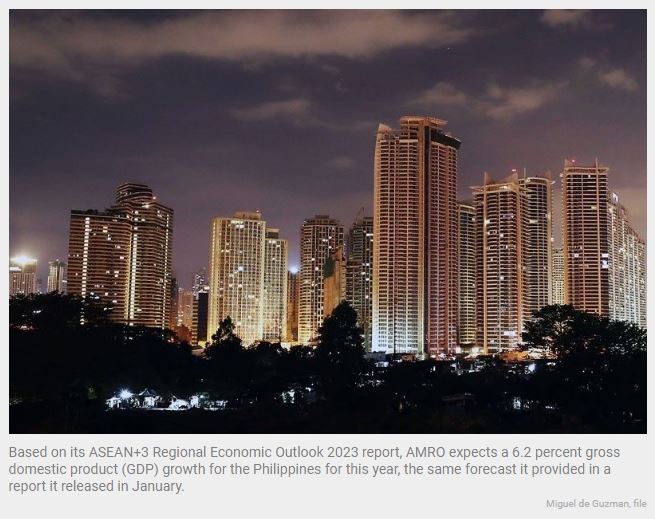Philippines faces slower growth in 2023
But remains top performer in Southeast Asia
MANILA, Philippines — The Philippines is expected to post the second fastest growth in Southeast Asia this year, but the projected growth is slower than last year due to challenges such as a global economic slowdown and high inflation, according to the Association of Southeast Asian Nations Plus 3 (ASEAN+3) Macroeconomic Research Office (AMRO).
Based on its ASEAN+3 Regional Economic Outlook 2023 report, AMRO expects a 6.2 percent gross domestic product (GDP) growth for the Philippines for this year, the same forecast it provided in a report it released in January.
This forecast is lower than the Philippines’ 7.6 percent GDP growth last year, but within the government’s six to seven percent growth target for 2023.
Within Southeast Asia, AMRO expects the Philippines to have the second fastest growth this year after Vietnam, which is projected to grow by 6.8 percent this year.
As for next year, AMRO is projecting a faster 6.5 percent GDP growth for the Philippines, which is at the low end of the government’s 6.5 to eight percent growth goal for 2024.
AMRO chief economist Hoe Ee Khor said in a virtual press conference, the Philippine economy is driven by remittances from overseas Filipino workers, as well as the services sector, which has benefitted from the digitalization of the economy.
He said tourism is also seen to drive growth for the Philippines.
“Tourism is an area which benefits enormously from infrastructure. They have a lot of beautiful beaches and attractions but they need to build the infrastructure and facility to attract the tourists,” he said.
AMRO said there are risks and challenges that cloud the Philippines’ economic growth such as elevated inflation and slower global economic growth.
“High inflation caused by the Ukraine crisis and the influence of other supply factors could dampen domestic consumption. High food and oil prices in particular have impacted households’ ability to afford other discretionary items,” AMRO said.
AMRO expects Philippine inflation to be at 5.9 percent this year and to ease to 3.8 percent next year from the average of 5.8 percent last year.
It said a weak economic recovery in China and slower global growth would affect exports, although the direct impact is expected to be limited given the less significant contribution of merchandise trade to the economy.
“Over a longer term, scarring effects of the pandemic could become more apparent. The challenge will be to address the learning losses from repeated school closures during the pandemic, which may impact productivity and growth potential,” AMRO said.
Climate change is also an important concern for the Philippines as it is among those most susceptible to natural disasters, which have social and economic costs.
“These points raise the urgency for the Philippines to take action to build resilient, sustainable, and inclusive long-term growth,” AMRO said.
For the ASEAN+3 region covering Southeast Asian countries as well as China, Hong Kong, Japan and South Korea, AMRO expects GDP growth to reach 4.6 percent this year, and 4.5 percent next year.
As for the ASEAN, AMRO is forecasting a 4.9 percent GDP growth this year, and a faster 5.2 percent growth next year.
“The ASEAN+3 region is expected to remain resilient notwithstanding the strong headwinds of weaker external demand and tighter global financial conditions. The boost in tourism and intraregional trade from the rebound in China’s economy will helpmitigate softer external demand from the United States and Europe,” Khor said.
While ASEAN+3 financial systems are now more resilient and well-regulated with lessons learned from the Asian financial crisis, the policymakers need to remain vigilant and continue to rebuild policy buffers, he said.
“They also need to remain flexible to extend additional support to the economy, if necessary,” he said.
Source: https://www.philstar.com/business/2023/04/09/2257437/philippines-faces-slower-growth-2023


 Thailand
Thailand




